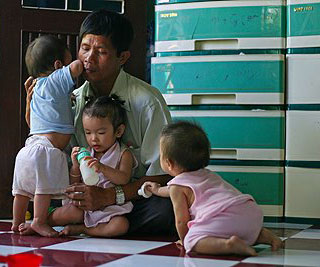It’s a heart-warming story that began more than a decade ago but is still used to inspire today – a poor construction worker in Vietnam who had little to his name used his own money to build a cemetery for aborted babies in 2001.
It all started when Mr Tong Phuoc Phuc would go to hospitals in the city of Nha Trang to collect aborted foetuses and bury them to give them a resting place.
He went on to adopt children of women who were considering abortion, and eventually start several orphanages to house these children.
His aim, he said, is to reunite the children with their mothers – many of them unwed – after the women had settled down and are better able to care for their children.
Mr Tong received a commendation letter from the Vietnamese president in 2006.
His story was reported by major media outlets in 2008, including Associated Press, and has been reproduced by many media outlets. Each time the story is repeated, there are people who will want to donate to his cause.
However, it appears things were not as it seemed in these “havens” run by Mr Tong.
 A 2012 documentary, Blush Of Fruit, showed viewers how some children were mistreated in one of the orphanages.
A 2012 documentary, Blush Of Fruit, showed viewers how some children were mistreated in one of the orphanages.
The children, mostly toddlers, were manhandled and “disciplined” in seemingly inappropriate manners.
They were neglected and abused by some of their caregivers – women, some of them pregnant, who were given shelter by Mr Tong. In exchange for that, the women had to take care of the children in the orphanage.
In some scenes, it’s obvious that the women were venting their frustration on the young children.
Without professional childcare training, the women caring for the children seemed clearly unfit for the task.
One of the women said that Mr Tong was rarely at the orphanage, sometimes turning up for just 10 minutes in the morning. She said she had not seen Mr Tong cradle the children or care for them in her time at the orphanage. She claimed that Mr Tong was running the orphanage more like a business than a charity.
In one scene, Mr Tong and the women appeared to be attentive and caring towards the children when donors visited. However, their behaviour changed visibly after the visitors left.
In an interview in the documentary, Mr Tong’s neighbour accused him of profiteering through the orphanage, saying that money has changed the man.
Filmmaker Jakeb Anhvu lived in Nha Trang for at least a year to shoot the documentary. He said he didn’t start filming until after three or four weeks at the orphanage – presumably for the women and Mr Tong to get used to the presence of the camera.
Seeing the documentary, one can’t help but feel that maybe, the “business” had gotten too big for Mr Tong.
The silver lining is that things seem to have gotten better in the orphanage.
Mr Anhvu said an Australian non-government organisation in Vietnam visited the orphanage in 2014 after trailers for the documentary were shown. They reported that the children were healthy and happy.
The orphanage was also more welcoming to volunteers and more transparent in its work.
Photos that volunteers took in 2014 showed the children that appeared in the documentary smiling and looking healthy.
sinsh@sph.com.sg





